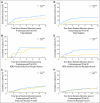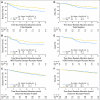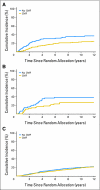Classical cyclophosphamide, methotrexate, and fluorouracil chemotherapy is more effective in triple-negative, node-negative breast cancer: results from two randomized trials of adjuvant chemoendocrine therapy for node-negative breast cancer
- PMID: 20458051
- PMCID: PMC2982784
- DOI: 10.1200/JCO.2009.25.9549
Classical cyclophosphamide, methotrexate, and fluorouracil chemotherapy is more effective in triple-negative, node-negative breast cancer: results from two randomized trials of adjuvant chemoendocrine therapy for node-negative breast cancer
Abstract
Purpose: Retrospective studies suggest that primary breast cancers lacking estrogen receptor (ER) and progesterone receptor (PR) and not overexpressing human epidermal growth factor receptor 2 (HER2; triple-negative tumors) are particularly sensitive to DNA-damaging chemotherapy with alkylating agents.
Patients and methods: Patients enrolled in International Breast Cancer Study Group Trials VIII and IX with node-negative, operable breast cancer and centrally assessed ER, PR, and HER2 were included (n = 2,257). The trials compared three or six courses of adjuvant classical cyclophosphamide, methotrexate, and fluorouracil (CMF) with or without endocrine therapy versus endocrine therapy alone. We explored patterns of recurrence by treatment according to three immunohistochemically defined tumor subtypes: triple negative, HER2 positive and endocrine receptor absent, and endocrine receptor present.
Results: Patients with triple-negative tumors (303 patients; 13%) were significantly more likely to have tumors > 2 cm and grade 3 compared with those in the HER2-positive, endocrine receptor-absent, and endocrine receptor-present subtypes. No clear chemotherapy benefit was observed in endocrine receptor-present disease (hazard ratio [HR], 0.90; 95% CI, 0.74 to 1.11). A statistically significantly greater benefit for chemotherapy versus no chemotherapy was observed in triple-negative breast cancer (HR, 0.46; 95% CI, 0.29 to 0.73; interaction P = .009 v endocrine receptor-present disease). The magnitude of the chemotherapy effect was lower in HER2-positive endocrine receptor-absent disease (HR, 0.58; 95% CI, 0.29 to 1.17; interaction P = .24 v endocrine receptor-present disease).
Conclusion: The magnitude of benefit of CMF chemotherapy is largest in patients with triple-negative, node-negative breast cancer.
Conflict of interest statement
Authors' disclosures of potential conflicts of interest and author contributions are found at the end of this article.
Figures






Similar articles
-
Chemoendocrine compared with endocrine adjuvant therapies for node-negative breast cancer: predictive value of centrally reviewed expression of estrogen and progesterone receptors--International Breast Cancer Study Group.J Clin Oncol. 2008 Mar 20;26(9):1404-10. doi: 10.1200/JCO.2007.10.6393. J Clin Oncol. 2008. PMID: 18349391 Clinical Trial.
-
Long-term results of International Breast Cancer Study Group Trial VIII: adjuvant chemotherapy plus goserelin compared with either therapy alone for premenopausal patients with node-negative breast cancer.Ann Oncol. 2011 Oct;22(10):2216-26. doi: 10.1093/annonc/mdq735. Epub 2011 Feb 16. Ann Oncol. 2011. PMID: 21325445 Free PMC article. Clinical Trial.
-
Endocrine responsiveness and tailoring adjuvant therapy for postmenopausal lymph node-negative breast cancer: a randomized trial.J Natl Cancer Inst. 2002 Jul 17;94(14):1054-65. doi: 10.1093/jnci/94.14.1054. J Natl Cancer Inst. 2002. PMID: 12122096 Clinical Trial.
-
Doxorubicin in combination with fluorouracil and cyclophosphamide (i.v. FAC regimen, day 1, 21) versus methotrexate in combination with fluorouracil and cyclophosphamide (i.v. CMF regimen, day 1, 21) as adjuvant chemotherapy for operable breast cancer: a study by the GEICAM group.Ann Oncol. 2003 Jun;14(6):833-42. doi: 10.1093/annonc/mdg260. Ann Oncol. 2003. PMID: 12796019 Review.
-
Adjuvant treatment in hormone receptor-positive early breast cancer: New approaches of endocrine therapy.Tumori. 2024 Jun;110(3):162-167. doi: 10.1177/03008916231216830. Epub 2023 Dec 19. Tumori. 2024. PMID: 38112006 Review.
Cited by
-
Triple-negative breast cancer: adjuvant therapeutic options.Chemother Res Pract. 2011;2011:696208. doi: 10.1155/2011/696208. Epub 2011 Jun 21. Chemother Res Pract. 2011. PMID: 22312556 Free PMC article.
-
Immunotherapy Treatment for Triple Negative Breast Cancer.Pharmaceuticals (Basel). 2021 Aug 4;14(8):763. doi: 10.3390/ph14080763. Pharmaceuticals (Basel). 2021. PMID: 34451860 Free PMC article. Review.
-
Prognostic Role of Adjuvant Chemotherapy in Node-Negative (N0), Triple-Negative (TN), Medullary Breast Cancer (MBC) in the Korean Population.PLoS One. 2015 Nov 12;10(11):e0140208. doi: 10.1371/journal.pone.0140208. eCollection 2015. PLoS One. 2015. PMID: 26562837 Free PMC article.
-
Evaluation of the Survival Benefit of Different Chemotherapy Regimens in Patients with T1-2N0 Triple-Negative Breast Cancer.J Breast Cancer. 2015 Sep;18(3):271-8. doi: 10.4048/jbc.2015.18.3.271. Epub 2015 Sep 24. J Breast Cancer. 2015. PMID: 26472978 Free PMC article.
-
Low-Dose Oral Cyclophosphamide and Methotrexate Maintenance for Hormone Receptor-Negative Early Breast Cancer: International Breast Cancer Study Group Trial 22-00.J Clin Oncol. 2016 Oct 1;34(28):3400-8. doi: 10.1200/JCO.2015.65.6595. Epub 2016 Jun 20. J Clin Oncol. 2016. PMID: 27325862 Free PMC article. Clinical Trial.
References
Publication types
MeSH terms
Substances
Grants and funding
LinkOut - more resources
Full Text Sources
Medical
Research Materials
Miscellaneous

